Our aim goes far beyond delving into recipes and teaching culinary techniques; we intend to promote sustainable eating as an essential part of preserving humans’ relationship with nature. As such, we invite anyone who shares this same conviction or has a secret family recipe they would like to share with the rest of us to visit us online or contact us at [email protected] for all collaborations and submissions. Let’s show appreciation for those that dedicate their lives using natural deliciousness to establish meaningful human bonds through cuisine!
For now, love yourself and enjoy this one ...
Now love yourself and enjoy this one ...
Quick, easy, and healthy, this Poached Fish recipe perfectly produces white and flaky meat out of any fish you choose.

Table of Contents
I used to be intimidated by cooking fish. I figured, a delicate meat requires delicate treatment. It was a logic that stuck with me far longer than I care to admit. Then a friend took me under her wing (or fin, perhaps) and showed me how easy a fish fry can be. Suddenly, a whole new world (er, sea) opened up to me. It was the biggest revelation in my seafood-cooking life… until now.
Poaching fish makes my previous methods of fish preparation seem as complicated as brain surgery. It is so simple, it is almost foolproof. In no time and with little effort, anyone can have a flaky fish on their plate. I almost feel like a fraud when I invite friends over for dinner and they praise my entree. Do I go ‘fishing’ for compliments? No, but I won’t toss them back in the water, if you know what I mean?
What had me ‘hooked’ was the fact I could use this method with pretty much any kind of fish I fancied. This opens this recipe up to an ocean of possibilities. Do you have fish on hand but not sure how to cook it? Give poaching a go.
Is Poached Fish Healthy?
So incredibly healthy. Fish provides protein and omega-3 fatty acids, which contribute to brain function and heart health. The other ingredients provide vitamins and antioxidants, and are low in calories. And by poaching, we avoid using any fats. Not surprisingly, this meal adheres to a Mediterranean diet, as well as low-carb/keto, paleo, and gluten-free diets.
Which Fish Do You Recommend?
When poaching, it’s important you use fish that is firm, that will hold together well. You will also want to find fresh fish with a mild scent. And try to deal with fish that is ethically sourced and sustainable. As for particular types, you’ve got a whole net’s worth to choose from. I mention cod (mild taste, firm texture) and salmon (rich taste, very firm), but you can also use halibut (lean, firm, and slightly sweet), haddock (similar to cod), sea bass (should go well with the garlic and onion), or trout (a freshwater fish; delicate but very tasty).
INGREDIENTS
- 1/2 medium onion, sliced
- 1/2 cup white wine
- 2 cloves garlic, crushed
- 1/2 lemon, sliced
- 1/2 tsp sea salt
- 4 filets of your preferred fish (e.g., cod, salmon)
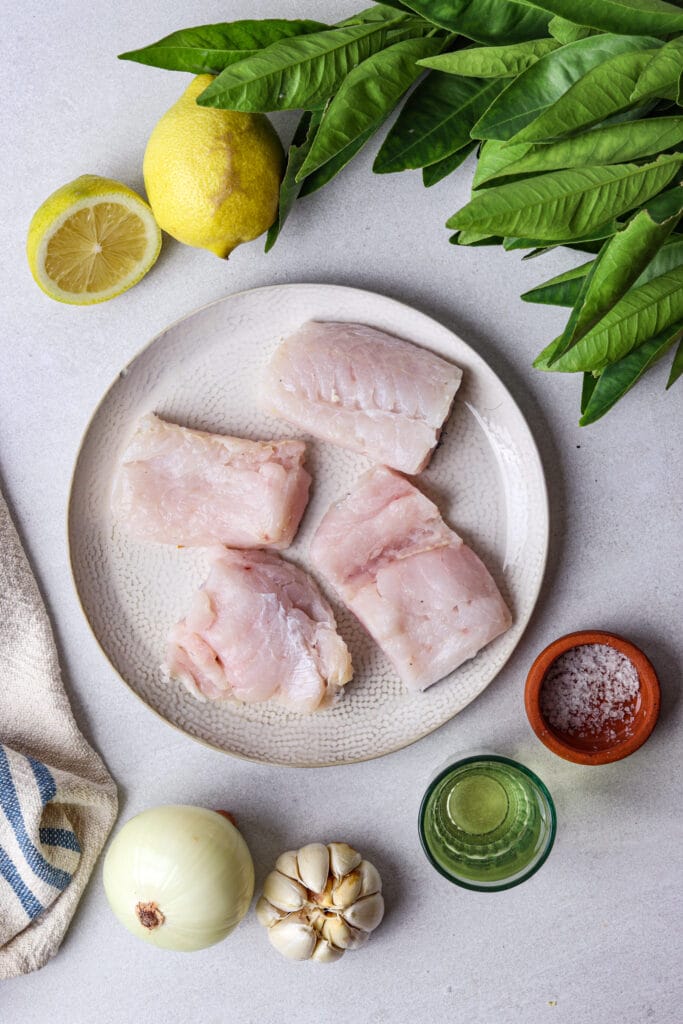
INSTRUCTIONS
Mix
Mix white wine, onion, garlic, lemon, and salt with water in a skillet and heat until just steaming.
Poach
Add fish to the skillet, maintaining a constant temperature.
Inspect
Ensure fish is poached to perfection by checking for flakiness or using a thermometer.
Serve
Remove the fish with care and serve hot.
Devour!
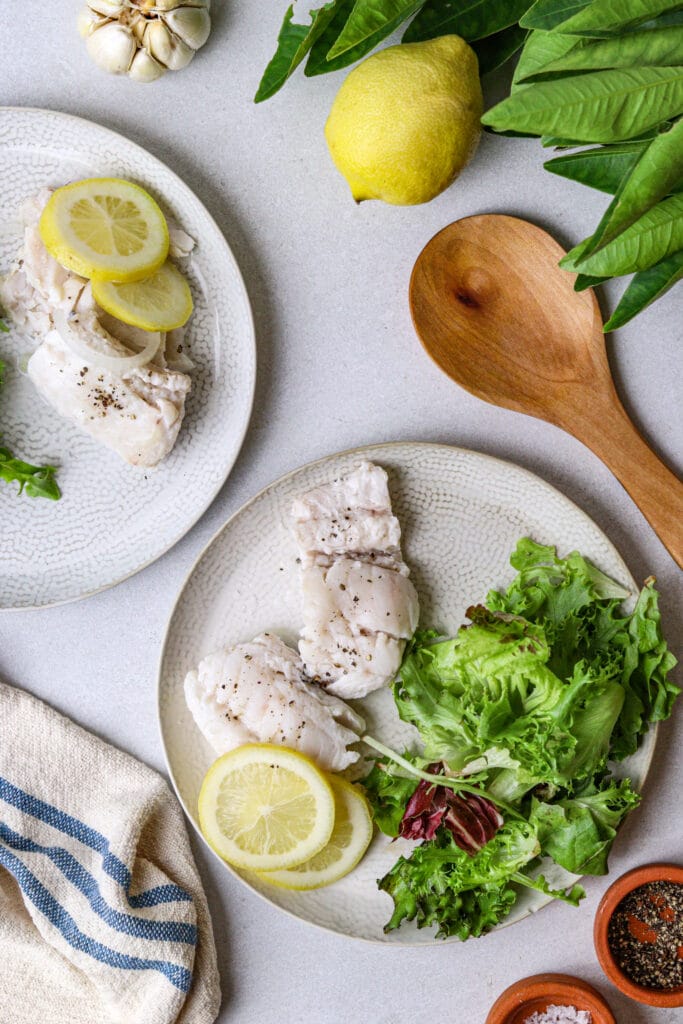
FAQs & Tips
Let the fish cool then store it in an airtight container. It should last in the fridge for up to two days. To reheat, put it in the microwave on LOW heat. I don’t recommend freezing it; the texture will change and will be, um… less than palatable.
You can use your microwave, sure. Put it in a microwave-safe bowl or dish and partially cover it. Cook it on HIGH for 3–5 minutes. Check the temperature of the meat using a thermometer to ensure it’s done.
The general rule is to use a wine you enjoy drinking (you can pour yourself a glass with whatever wine is left over!) but if you’re looking for suggestions, any dry, unoaked (or lightly oaked), citrusy, or herbaceous wine will work. I only recommend avoiding sweet wines; their sugars will overpower the fish.
If you think there is sufficient flavor with the onion, garlic, lemon, and salt, then feel free to omit the wine and use water instead. The same steps apply.
That’s a matter of preference. When I cook fish any other way, I leave the skin on. I find it crispy and tasty. But you won’t get that finish when poaching so it may be easier to just remove it from the get-go. If you do decide to keep it on, poach with the skin-side down.
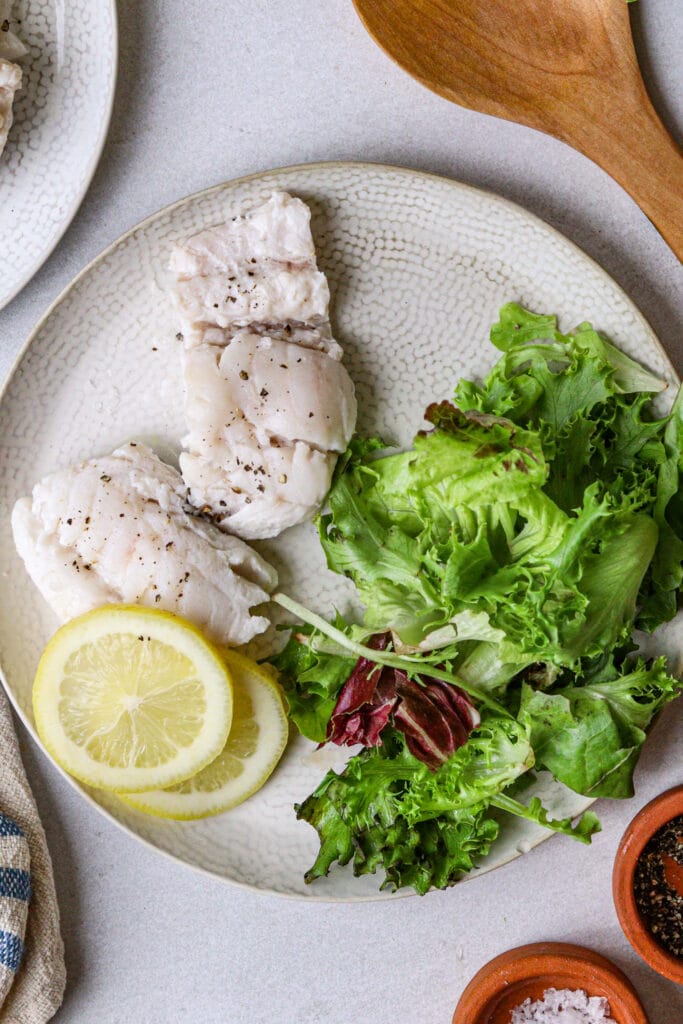
Serving Suggestions
I usually call upon some oven-roasted potatoes, cauliflower rice, roasted broccoli whenever I serve fish. All three are healthy additions to this meal; all three taste great with the lemon, onion, and garlic. You can also do up a small pasta dish or side salad, along with a loaf of crusty bread to soak up that flavorful juice.
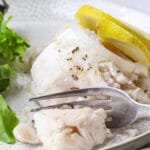
Perfect Poached Fish
Ingredients
- 1/2 cup white wine unbranded
- 1/2 medium onion sliced
- 2 cloves garlic crushed
- 1/2 lemon sliced
- 1/2 tsp sea salt
- 4 filets of your preferred fish such as cod or salmon
Instructions
- Combine white wine, onion slices, crushed garlic, lemon slices, and sea salt in a large skillet with high sides. Add enough water to rise 2 inches above the mixture. Heat on medium until the water reaches 140°F (it should be steaming with a slight movement). Reduce heat to maintain temperature.

- Place the fish filets in the skillet, ensuring the water temperature remains steady at 140°F (otherwise you risk overcooking).
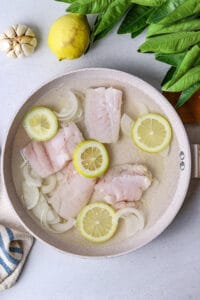
- Poach the fish until it reaches an internal temperature of 140°F. It typically takes about 10 minutes, depending on thickness. It is ready when the fish flakes with a fork.
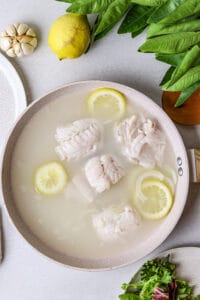
- Using a slotted spatula, carefully lift the fish from the poaching liquid and serve immediately. DEVOUR!
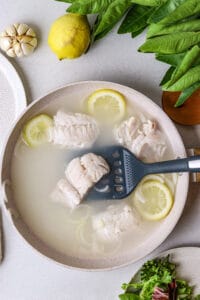
Nutrition
The post Perfect Poached Fish appeared first on Food Faith Fitness.
References:
By: wordpress_central_prodTitle: Perfect Poached Fish
Sourced From: www.foodfaithfitness.com/poached-fish/
Published Date: Mon, 18 Mar 2024 17:00:10 +0000
Frequently Asked Questions
Should You Use Herbs and Spices for Brain Health?
Herbs and spices have been used for centuries to improve brain health. Research shows that these natural remedies may help prevent dementia and Alzheimer's. Some herbs may even boost memory.
However, no scientific evidence proves that eating an herb-rich diet can keep your mind sharp. When it comes to improving cognitive function, there are more effective ways to do it.
One study found that older adults who took 1000 mg of vitamin B6 daily had fewer mental lapses than those taking placebo pills. Another study showed that drinking coffee could increase blood flow to the brain. Other studies suggest that exercise, socialization, and sleep improve brain health.
The bottom line is that herbs and spices probably won't make much difference to your overall health. But they might give you extra energy and focus, which can come in handy during the day.
Is basil good for kidneys?
The answer is yes. Basil is an excellent food for kidney health. It contains potassium which helps reduce high blood pressure. It also contains vitamin K, which is essential for bone strength. As well as this, it is rich in antioxidants which help protect against heart disease.
Basil is great for digestion too. It contains digestive enzymes that break down protein and carbohydrates. This makes it easier to absorb nutrients from your meals.
Basil is a wonderful addition to any diet. Try sprinkling some over pasta dishes, salads, soups, and sandwiches. Or add little stir-fried vegetables, chicken, fish, meat, and tofu.
It's delicious in pesto sauce and fresh in salad dressings. You'll find many recipes online where you can learn how to cook with basil.
Try making basil oil by adding a few drops of pure olive oil to a jar filled with chopped basil leaves. Let it steep overnight, and then strain out the leaves. Use the oil as a massage oil or rub it onto your skin.
It will leave your skin soft and smooth.
What are healing flowers?
Healing flowers are plants that promote peace and tranquillity. They help us unwind after a stressful day and make us feel more relaxed.
They also help us connect to our inner selves and reconnect with nature.
These beautiful blooms are used for meditation, prayer, and contemplation.
We call hundreds of varieties of flowering plants ‘healing’ because they provide such a fantastic experience.
This list includes roses, lilies, irises, daffodils, peonies, tulips, hyacinths, and many more.
But there are two species that I find particularly special. These are the Geranium and Lilium.
Geraniums are very easy to grow and come in various colors. Liliums are also known as lily-of-the-valley, which means 'lily' and 'valley.' Both of these species are popular garden flowers.
Healing flowers are often found growing near water. They are said to bring peace and calmness to those who meditate with them.
In ancient times, people would light candles in flower petals to symbolize the sun. This way, they could honor the sun without needing to go outdoors.
Some say that when you look at these flowers, you may see angels dancing.
Why do some love coriander and others don't?
Some people hate coriander, while others love it. But why?
Coriander is an herb that grows in warm climates throughout the world. It is native to both North America and Europe.
The leaves of the plant are used in cooking and can also be found in condiments such as salad dressings and dips. When added to food, coriander provides a spicy flavor.
Many people love its taste because it adds a fresh flavor to dishes without overpowering them. Others dislike the smell and taste of coriander because they find it too strong.
But there is more to coriander than meets the eye. There are two types of coriander – sweet and hot. Sweet coriander is milder and sweeter tasting compared to hot coriander.
Sweet coriander is usually grown for its seeds, often called cilantro. This type of coriander is easy to grow and is very low maintenance.
Hot coriander is most commonly used in Indian cuisine. Hot coriander gives a rich flavor to curries and sauces, making it popular among Indians.
Some people say that hot coriander tastes better than sweet coriander. However, the opposite is true for those who prefer sweet coriander.
There are many reasons why people enjoy different varieties of coriander. For example, one person may love the taste of coriander, while another enjoys the aroma.
Whether you like sweet or hot coriander, you might be surprised to learn that you can buy both types of coriander online.
Statistics
- The herbs market is highly competitive, with over 1,000 herb suppliers and over 15,000 herbs products available in the United States alone.
- Studies have shown that cinnamon can lower fasting blood sugars by 10-29% in diabetic patients, which is a significant amount (9Trusted Source10Trusted (healthline.com)
External Links
[TAG30]
[TAG33]
- Peppermint oil (Mintoil®) in the treatment of irritable bowel syndrome: A prospective, double-blind placebo-controlled randomized trial
- Curcumin reverses the effects of chronic stress on behavior, the HPA axis, BDNF expression, and phosphorylation of CREB
[TAG36]
[TAG38]
How To
How To Upcycle Herbs After Making Infusions, Oils, Tinctures, And More?
There are more ways to use herbs than you might realize. This is why it's essential to keep an open mind when learning how to make herbal infusions, oils, tinctures, and more.
You'll find that there are many methods for making these products, and even though they may seem similar, each method has its benefits.
For example, some methods include creating decoctions, boiling water or alcohol with the herb(s), and letting them simmer for a while. These infusions are solid and potent because they contain higher concentrations of active compounds.
Another type of infusion includes macerating the herb(s), which means soaking them in liquid for a few hours or even overnight. Macerations tend to produce milder results because the plant material isn't boiled.
Some cold-infused forms involve steeping herbs in cool liquids such as ice cubes or cold water. Cold infusions are gentler than hot ones, often used to treat minor ailments.
Herbal oil extraction involves heating the herb(s) to release the essential oils. You can either do this yourself or have someone help you out with it.
Finally, there are tinctures made by mixing herbs with alcohol. They're usually taken orally and are very effective for treating coughs, colds, and flu symptoms.
The best way to learn how to create infused products is to experiment with various techniques. Each technique offers a different potency and effectiveness, depending on the herb(s) you choose.
Once you've tried a few different methods, you'll begin to develop your preferences. In time, you'll be able to determine which techniques work well for you and which aren't worth pursuing.
 |
[TAG40]This Irish-inspired colcannon soup is easy to make with creamy potatoes, kale and cheddar cheese. The last time I made colcannon (traditional Irish mashed |
 |
[TAG41]This Irish kale colcannon recipe is perfectly buttery and fluffy and easy to make with a handful of basic ingredients. St. Patrick’s Day is just around the |
 |
[TAG42]Easy to make full flavoured recipes. Life is too short for boring food! |
 |
[TAG43]Hello hello! Just wanted to pop in with a cute little life update. ♡ I’m delighted to share that our sweet son, Milo Alexander Martin, came to join our family |
 |
[TAG44]This vibrant lemony broccoli pesto pasta is quick and easy to make and full of fresh flavors. Your veggies, greens, and pasta…all in one gorgeous dish! ♡ We’re |
 |
[TAG45]HEALTHY & KID-FRIENDLY MEALS easy dinner recipes made in minutes. The Latest Recipes st. Patrick's Day Recipes Hello! I'm Sara! Welcome to Dinner at the Zoo! |
 |
[TAG46]This simple roasted carrot soup recipe is made with creamy tahini and topped with crispy za’atar chickpeas. Naturally gluten-free, vegetarian and vegan. If you |
 |
[TAG47]My longtime favorite flourless cake recipe is decadently rich and delicious, naturally gluten-free, and easy to make in under 1 hour! Trust me, this flourless |
 |
[TAG48]From comfort foods to indulgent dishes browse hundreds of recipes that your family will love and make over and over again. Cooking Classy has never been easier, |
 |
[TAG49]This vegetarian cabbage roll soup is filled with protein-rich lentils and all of the delicious flavors you love from traditional cabbage rolls. Naturally |
 |
[TAG50]These zesty roasted sweet potato and chickpea bowls are layered with sautéed spinach and brown rice and tossed with my favorite 4-ingredient chipotle tahini |
 |
[TAG51]A family food blog with hundreds of simple, tested and approved recipes. Find easy step-by-step photo cooking instructions and video recipes. |
 |
[TAG52]This classic matcha latte recipe is easy to make and customize to your liking and always so delicious. The older I get, the more I’m convinced that one of |
 |
[TAG53]This veggie-loaded broccoli cheese soup recipe is perfectly velvety and creamy without using heavy cream. Instant Pot, Crock-Pot and stovetop options all |
 |
[TAG54]find out hundres of delicous food recipes |
 |
[TAG55]This winter farro salad recipe is made with the most delicious blend of seasonal fruit, greens, nuts, crumbled cheese and tossed with a vibrant orange ginger |
 |
[TAG56]This lovely white wine sautéed mushrooms recipe is quick and easy to make, full of rich savory flavors, and can pair well as a side dish with many different |
 |
[TAG57]The food blog with mostly healthy recipes made with real, whole foods inspiring more people to get into the kitchen and cook something good. |
 |
[TAG58]This traditional Swedish meatballs recipe is bursting with rich, savory flavors and topped with a creamy gravy. Always so comforting served over mashed |
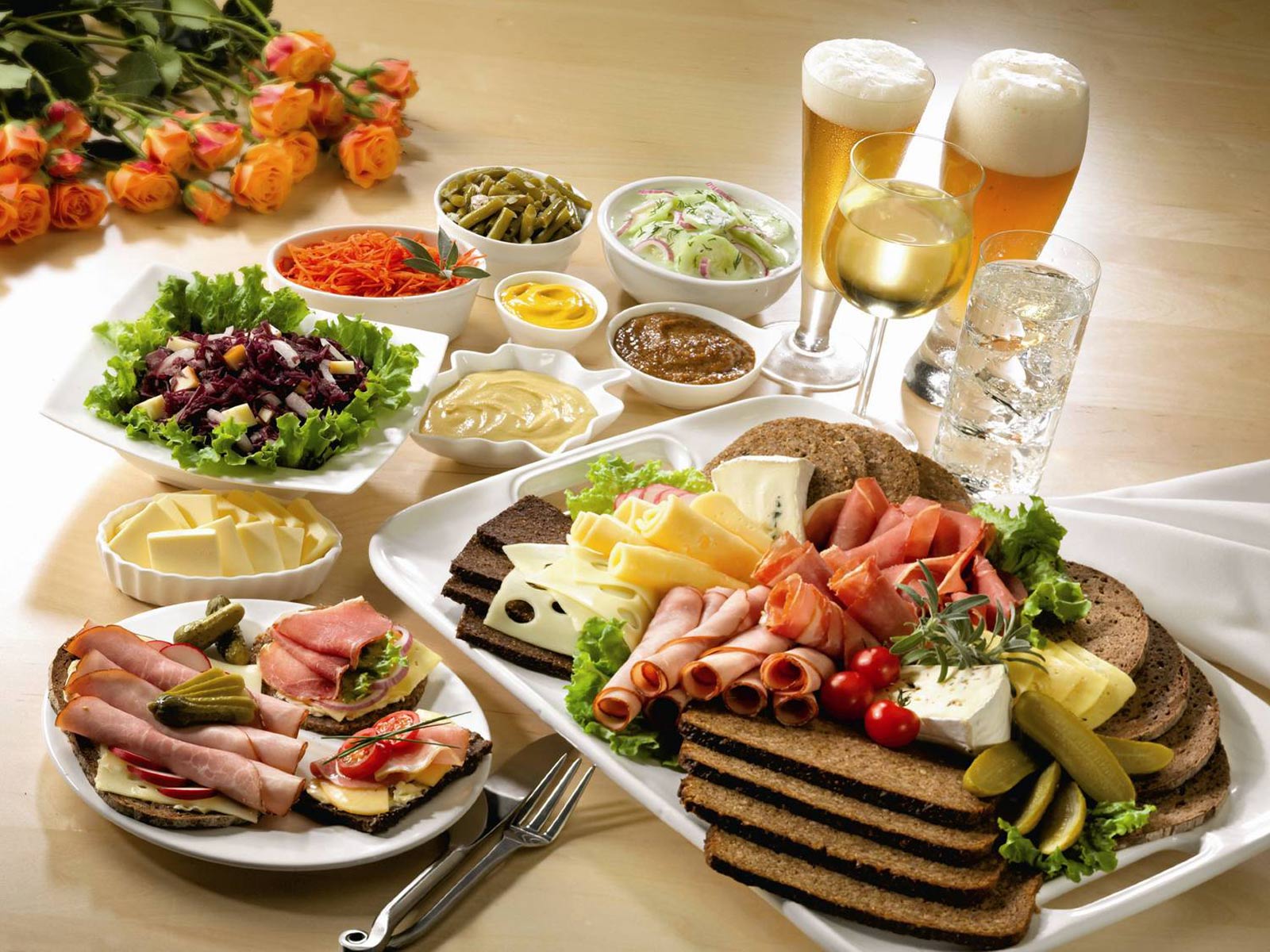 |
[TAG59]A food blog with hundreds of quick and easy dinner recipes. Classics done right, incredible one pot recipes, Asian takeout at home and holiday feasting! |
Did you miss our previous article...
https://belovedsaffron.com/recipes/banana-cake
.png)





